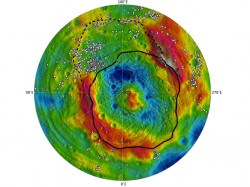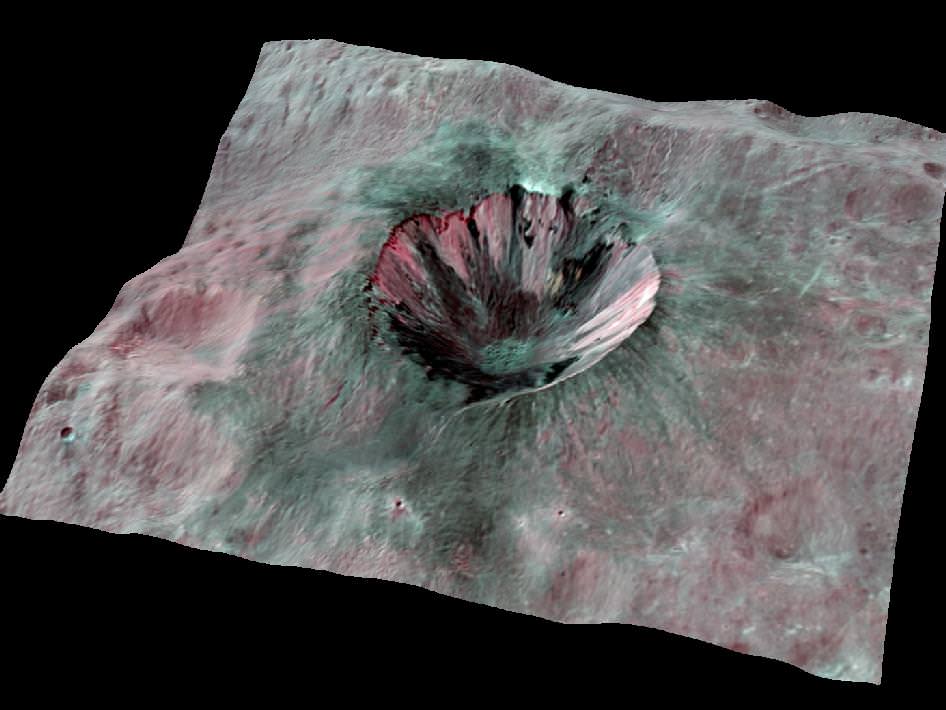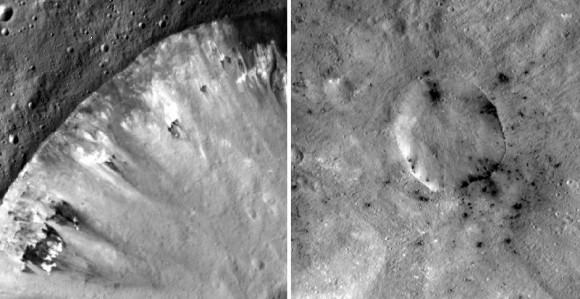Composite-color 3D image of Cornelia crater on Vesta (NASA/JPL-Caltech/UCLA/MPS/DLR/IDA)
Ever since arriving at Vesta in July 2011, NASA’s Dawn spacecraft has been capturing high-resolution images of the protoplanet’s surface, revealing a surprisingly varied and complex terrain covered in ridges, hills, grooves and, of course, craters of many different sizes and ages. Many of Vesta’s largest craters exhibit strange dark stains and splotches within and around them, some literally darker than coal. These stains were a puzzle to scientists when they were first seen, but the latest research now confirms that they may actually be the remains of the ancient impacts that caused them: dark deposits left by the myriad of carbon-rich objects that struck Vesta over the past four-and-a-half billion years.
Even though Vesta had a completely molten surface 4.5 billion years ago it’s believed that its crust likely solidified within a few million years, making the 530-km (329-mile) -wide world a literal time capsule for events taking place in the inner Solar System since then… one reason why Vesta was chosen as a target for the Dawn mission.
 Using data acquired by Dawn during its year in orbit around Vesta, a team led by researchers from Germany’s Max Planck Institute for Solar System Research and the University of North Dakota investigated the dark material seen lining the edges of large impact basins located on the protoplanet’s southern hemisphere. What they determined was that much of the material was delivered during an initial large, low-velocity impact event 2–3 billion years ago that created the largest basin — Veneneia — and was then partially covered by a later impact that created the smaller basin that’s nearly centered on Vesta’s southern pole — Rheasilva.
Using data acquired by Dawn during its year in orbit around Vesta, a team led by researchers from Germany’s Max Planck Institute for Solar System Research and the University of North Dakota investigated the dark material seen lining the edges of large impact basins located on the protoplanet’s southern hemisphere. What they determined was that much of the material was delivered during an initial large, low-velocity impact event 2–3 billion years ago that created the largest basin — Veneneia — and was then partially covered by a later impact that created the smaller basin that’s nearly centered on Vesta’s southern pole — Rheasilva.
“The evidence suggests that the dark material on Vesta is rich in carbonaceous material and was brought there by collisions with smaller asteroids.”
– Vishnu Reddy, lead author, Max Planck Institute for Solar System Research and the University of North Dakota
Dawn framing camera images of dark material on Vesta. (NASA/JPL-Caltech/UCLA/MPS/DLR/IDA)
Subsequent smaller asteroid impacts over the millennia likely brought more carbonaceous material to Vesta’s surface, both delivering it as well as revealing any that may have existed beneath brighter surfaces.
Read more: Asteroid’s Unusual Light and Dark Crater
The dark, carbon-rich material observed on Vesta by Dawn also seems to match up with similarly dark clasts found in meteorites that have landed on Earth which are thought to have originated from Vesta.
“Our analysis of the dark material on Vesta and comparisons with laboratory studies of HED meteorites for the first time proves directly that these meteorites are fragments from Vesta,” said Lucille Le Corre from the Max Planck Institute for Solar System Research, another lead author of the study.
If evidence of such collisions between worlds can be found on Vesta, it’s likely that similar events were occurring all across the inner solar system during its early days, providing a clue as to how carbon-rich organic material was delivered to Earth — and possibly Mars as well. Such material — the dark stains we see today lining Vesta’s craters — would have helped form the very building blocks of life on our planet.
The team’s findings were published in the November/December issue of the journal Icarus.
Read more on the Max Planck Institute’s news page here, and on the NASA release here. Learn more about the Dawn mission in the video below, narrated by Leonard Nimoy.



solar power once again. wheres the mirrors in space?
concentrating mirrors would seem so useful.
Leonard Nimoy still the great explainer.
Relevant paper: Delivery of Dark Material to Vesta via Carbonaceous Chondritic Impacts.
I’m guessing that first image has an exaggerated vertical scale?